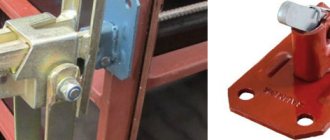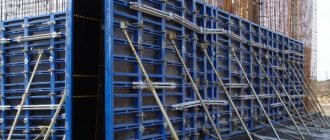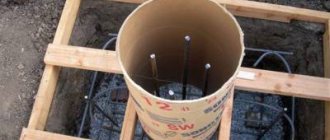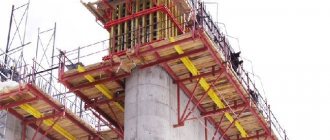Description and properties of studs
Before pouring concrete, you need to assemble the pouring forms. To assemble structures, special panels are used, and special formwork pins are used to fasten the panels. They perform the functions of couplers, holding the installed sheets in the desired position, despite the applied loads.
The pin is a universal fastening material for assembling various shapes. High-quality steel is used to manufacture these parts, due to which they are able to withstand significant tensile loads. The fastening element consists of the following parts:
- the stud itself is a threaded steel rod;
- nuts, they are installed on both sides;
- washers.
Advice! Nuts are made from cast iron, which is often coated with a layer of zinc to protect against corrosion.
The size of screeds for construction formwork varies widely; products range in length from 500 to 6000 mm, with a maximum diameter of 17 mm. Installation of formwork using screw ties is as simple and quick as possible, and the fastenings are quite reliable.
Tightening screws for casting formwork
When constructing monolithic structures, you cannot do without formwork. It gives the concrete pour the required dimensions and geometric shapes. To prevent the formwork from collapsing under the pressure of the solution, its walls must be securely fastened. Construction experts recommend purchasing clamping screws for this.
Description and characteristics
The pin serves to tighten the panels and ensure the designed width of the concrete pour. It is a metal rod with a large thread that looks like a thick reinforcing bar. The strength of the foundation and the integrity of the entire building depend on its quality parameters and proper installation. Low-alloy steel ensures the stability of the formwork under dynamic and static loads.
The diameter of the screw is constant and is 17 mm (along the inner edge 15 mm). The thread pitch also remains unchanged - 10 mm, the length of the products depends on the thickness of the concrete monolith and varies from 0.5 to 6 m. The weight of a linear meter is about 1.4 kg.
Accessories for formwork
A screw tie is a universal fastening material that connects parallel panels and takes on the pressure of the concrete mass. Thanks to this, the monolithic structure is solid and durable.
In addition to the studs, the kit includes several parts:
- Nut - wing parts have special projections and are tightened without a key. Hinge-type nuts ensure that the panels are tied at an angle of 10°. 2 nuts are used per rod.
- A kingpin (end anchor) is a type of screw with a limiter at the end, fixed perpendicularly. Used in assembling formwork for columns and end parts of walls.
- PVC pipe - simultaneously plays 2 roles: it is a spacer between the walls of the mold and a protective shell for the stud. The tube makes it easier to dismantle the system.
- Retainers are plastic nozzles in the form of a cone (star, triangle, chair, etc.) located at the ends of the tubes.
- The washer is a square flat steel piece with a hole in the center with a diameter of 20 mm. Serves to distribute the load and protect against rupture.
- Plug plug - prevents concrete from getting inside the PVC pipe.
Designers provide devices with various characteristics that ensure the integrity of the prefabricated form, prevent leaks and reduce concrete consumption. The list of auxiliary systems includes:
- The wedge and elongated lock ensures tight joining of the panels.
- Struts - support for the walls.
- Brackets and lubricant make the connector easier.
There are also special spring clamps.
The technological process of monolithic construction in brief form looks like this:
- Installation of formwork that defines the configuration of future walls.
- Installation of reinforcement cage between walls.
- Pouring concrete solution.
- Dismantling (after the foundation has completely hardened). If a permanent structure was used in the work, then it is left untouched.
To prevent the formwork from deforming and moving apart during pouring and setting of concrete, its walls are fixed with a screed.
- Drill holes with a diameter of 22 mm in the panels.
- Place a pin on one side and put the components on it in this order: retainer – piece of PVC pipe – retainer. In this case, you need to ensure that the tops of the stops are directed away from the panels towards the tube.
- Remove the clamping screw through the hole in the parallel panel.
- Install flat washers on both sides, screw on the nuts and secure the plugs.
To fasten 2 parallel walls without distortions, you will need at least 3 studs.
It is much more profitable not to buy fasteners, but to rent them - this will significantly reduce the estimated costs. By using a complete set of screw ties (tubes, clamps, plugs), it is possible to keep the studs in excellent condition for a long time without changing the quality characteristics.
Scope of application
The formwork screed is used to connect parallel panels of a structure, so that after pouring concrete they do not move apart in different directions. Therefore, the screed pin must withstand heavy loads, resisting the pressure of the concrete mixture.
To fix the ties of the formwork panels, two nuts are used; they are installed on the outer sides of the panels being connected. The area of the nut is 9-10 cm, which ensures a strong fit to the surface of the shields. For severe loads, this contact area is insufficient, so washers are additionally used.
Studs are used to assemble formwork in the construction of monolithic structures. This fastener is not cheap, so it is used repeatedly. That is, after the concrete has hardened, the formwork is dismantled, removing the screw ties and moved to another place.
Advice! To make it easy to remove fasteners during the construction of monolithic structures, when assembling the formwork, they are installed in special plastic tubes. Thanks to this, the rods do not come into contact with the concrete and the reuse of the stud becomes possible.
When pouring the foundation and constructing other structures with a wall width of more than 60 cm, special rigid PVC pipes are used to install fasteners when assembling the formwork; this eliminates deformation after pouring the concrete.
Homemade screed for formwork using studs, PVC pipes, washers and nuts.
Posted By: YanaShi 10/06/2016
Today we wanted to pay special attention to formwork screeding and answer common questions: why is it necessary to screed the grillage (foundation) formwork, how and what to make it from, when to remove it, and, of course, how much does it cost to screed the formwork with your own hands.
To begin with, I would like to note that when studying this issue, we came across quite a lot of messages and comments on the Internet, how when pouring the foundation (grillage) with concrete, the formwork simply came apart at the seams or gave such cracks, which led to very unpleasant results. It was necessary to restore the desired structure, give the foundation the desired shape and re-fill the concrete. And this, of course, is a loss of energy, time and money, which is already lacking in our lives...
Why do you still need to screed the formwork under the grillage (foundation)? It is necessary to reduce the pressure on the formwork when pouring concrete mixture into it. Thus, the formwork becomes stronger due to the distribution of the load between the parallel sides of the formwork and the screed. The absence of a screed can lead to collapse or expansion of the formwork walls, and thereby compromise the integrity of the structure being poured with concrete.
After we made the reinforcement frame for our grillage of the future foundation with our own hands and moved on to making the formwork, we were faced with the question of screeding it. In principle, we quickly decided that we would tighten the formwork using homemade tension screws or pins, so we decided to talk about this method and our experience with it.
To screed our removable formwork we needed:
— galvanized rod DIN 975, 2 meters, diameter 12 mm, price 152 rubles. for 1 piece, 80 pieces for the amount of 12,160 rubles.
- rigid PVC pipe, 2 meters, diameter 16 mm - price 11 rubles. for 1 piece, 88 pieces for the amount of 968 rubles.
— galvanized washer, 12 mm. for the amount of 500 rubles. (sold by weight)
— galvanized nut, 12 mm. for the amount of 900 rubles. (sold by weight)
Rods (studs) and PVC tubes for screeding formwork.
Of course, everything was taken with some reserve, so the amounts and quantities are approximate.
The total cost of screeding the formwork with our own hands was approximately 14,500 rubles. A huge advantage of our screed is that, despite its expensive cost, it will have a so-called second life, but more on that a little later...
So, how did the process of screeding the formwork take place? The first thing we needed to do was cut the rods (or in other words, studs) and PVC pipes. The length of the pins was 50 cm, the length of the tubes was 35 cm. In order to save time and effort when measuring these products, we came up with the following design. We place a homemade wooden table next to the vertical stop at the distance we need, respectively, for studs 50 cm, for tubes 35 cm. Then on the table we install a holder made of pieces of wood for a rod or tube perpendicular to the vertical surface, insert the desired element into the holder and saw it off. Our device can be seen in the photo below.
Homemade table for cutting pins and PVC pipes.
After the preparatory work came to an end, we moved on to the installation and installation of wooden formwork, and then to its screed. For reliability, we made screeds approximately every 50 cm in 2 rows, 10 cm away from the corners. First, markings were made with a marker, then we drilled holes with a drill, after which we pulled together the entire formwork. First of all, metal rods with PVC plastic tubes on them were inserted, then the structure was fixed using washers (on both sides) and nuts (only on the outside). For general reliability of the formwork, metal corners were installed in the corners. What we came up with can be seen in the photo below.
Screeding the formwork with studs.
We would like to boast that the grillage filling went off with a bang. The formwork easily withstood the entire load, no cracks or discrepancies appeared.
Already 3 days after pouring the concrete, we removed the screed, and then the grillage formwork itself. For the foundation we used concrete grade 350, it hardens quite quickly, which is why the demoulding time is so short. The process of removing the screed is quite simple, although some questions arise about it. We will answer the most popular one right away. Yes, plastic PVC pipes remain in the concrete and do not go anywhere. But the rods (studs) are simply knocked out of the foundation.
As you already understood, the most expensive part of screeding formwork are the very studs on which we spent most of the budget. We initially did not want to rent screeds, because... We had our own plans for the bars. After we had them as screeds, we confidently put them aside intact and safe until the next use, namely for interfloor reinforcement. So all the materials are used, nothing extra will be left in the construction of the house with your own hands =)
Types of studs
There are two types of tie rods for formwork:
- type A. The product has the same dimensions in the threaded and smooth parts;
- type B. The product has a smaller diameter of the smooth part and an increased diameter of the thread.
In addition to metal pins, other product options are used when assembling formwork, in particular:
- fiberglass coupling screws. These products are characterized by low thermal conductivity and low shear resistance. As a rule, these products are disposable; they are cut off when dismantling the structure and left in the concrete;
- plastic screed for formwork has an affordable price. A regular plastic screed is used to assemble molds for casting structures with a width of no more than 250 mm. When assembling forms for thicker walls (up to 500 mm), a plastic extension is used simultaneously with the screed.
Benefits of renting
Renting studs for formwork in Moscow is a popular service that is always in demand. The benefits are obvious. Firstly, such fasteners will cost much less than purchased ones. Secondly, such products have an unpleasant property - they constantly disappear somewhere. You think that you have a complete set, but in fact most of the ties were “rented” by friends and it’s impossible to really remember who it was. This is not about theft, but about basic mutual assistance between builders. As a result, even if you have your own reserves, you still have to borrow.
Thirdly, the length of the studs must correspond to the parameters of the object they will serve. If the dimensions turn out to be unsuitable, you will have to go again to get the necessary fasteners. By regularly using the rental service, you will avoid all these hassles. The purchase is financially more profitable only for companies that have regular orders. For others, it is more convenient and easier to rent screeds. Our company will be happy to provide you with this service.
Installation and dismantling
When installing formwork, the following operations are carried out:
- holes are prepared in the walls for installing plastic pipes;
- rods are inserted into the tubes, their length should be much greater than the width between the shields, so that there is room for attaching the nuts;
- the shields are leveled, the rods are fixed with nuts;
- concrete is poured into the molds;
- after the mixture has hardened by at least 70%, the nuts are unscrewed and the rods are removed. The plastic lines remain inside the concrete structure. Thanks to the use of plastic lines, the structure can be easily dismantled, and the studs can be reused, reducing construction costs.
Fastening the formwork with studs ensures the reliability of the structure; in addition, installation and dismantling is carried out with minimal labor and time costs. To carry out installation you do not need to be a highly qualified specialist. Another advantage is the versatility of the fastener; it can be used for small volumes of work and for large-scale construction.
Fastening formwork with studs: advantages
The entire structure of fastening the formwork with studs is designed for comfortable use in the construction industry. Considering the functions it performs, the following main advantages are highlighted:
- Product reliability, which is achieved through the use of durable materials such as steel;
- Technology and speed. The simplicity of all elements and well-thought-out technology allows people who do not have much experience in the construction of building structures to work with it;
- Versatility. The production of pins for fastening formwork is designed for both large volumes of concreting and smaller volumes.
Individual and industrial construction of multi-storey monolithic buildings, bridges and overpasses is carried out using formwork floors. They are easy to install and...
For any concrete structures, formwork will be required during construction. This is not a minor job at all, as many may think. .
The devices that appeared during the development of monolithic construction technology simplified and reduced the cost of previously labor-intensive and costly construction processes. A simple invention - a stand.
The spring clamp for formwork has proven its effectiveness in practice. Tens of thousands of residential buildings, as well as other premises, have been built using it.
Polyethylene.
Tubes made of polyethylene (PE, TPE) are used where there are no high pressure and temperature requirements. They have moderate resistance to chemical products and compounds. The main advantage is the low price. Use in critical areas is not advisable. Operating temperature range -10+60. As the temperature increases, the operating pressure decreases significantly. As for polyethylene hoses, this product does not apply to pneumatics.
Polyurethane.
Polyurethane (TPC, TPU) has become widespread due to its high elasticity and resistance to mechanical stress. Sleeves and tubes made of polyurethane work well in the temperature range -20+60. Polyurethane
resistant to gasoline, kerosene and various oils, but has poor resistance to acids and esters.
Polyamide.
Polyamide PA 12, polyamide PA11, Rilsan, TRN, TRN NX, TSP are all different names for polyamide. The more common designation for pneumatics for this material is Rilsan . Rilsan tubes are currently perhaps one of the most modern and in demand. Rilsan has a lot of positive properties. Rilsan tubes have high chemical resistance to oils, fats, and some solvents. Operating temperature range -40…+100?С. Widely used in various industries.
Rubber hose
Rubber hose
has become widespread due to its ease of manufacture, reliability, versatility and relatively low cost.
In most cases, a rubber hose for compressed air is a long hose designed to connect a compressor to a pneumatic tool or sandblaster. Depending on the purpose, a long rubber hose has a different internal diameter. So, when operating pneumatic tools, a hose with a diameter of 9 to 25 mm is used; when operating sandblasting units, a hose with a diameter of 25-32 mm is used as an air hose. The working pressure of the pneumatic hose is no more than 10 bar.
When performing sandblasting work, the greatest importance should be given to the abrasive blasting hose. The abrasive blasting hose has much thicker walls than the air hose and is much more resistant to wear. The maximum length of the abrasive blasting hose coil is limited to 40 meters. The working pressure of the sandblasting hose is 12 bar.
Plastering hoses are designed to supply mortar from the plaster station to the place where the mortar is poured. The internal diameter is from 38 to 100 mm, the working pressure in some cases reaches 40 bar. Length is limited to 20 meters. In generally accepted terminology it is designated as a class Sh hose.
The welding hose is designed for gas welding and gas cutting work. Welding hoses are divided into three classes.
- The first class is a hose for flammable gases such as propane, methane, natural gas, and has a red color or a red stripe. Working pressure 6.3 atm.
- The second class is an oil and petrol resistant hose for kerosene-oxygen cutting and operation of petrol cutters. Working pressure 6.3 atm.
- The third class is an oxygen hose, respectively, for oxygen, which may have a blue stripe. Working pressure 20 atmospheres.
Polyvinyl chloride PVC.
PVC pipes (PV) and reinforced PVC hoses (PVC)
, polyvinyl chloride is perhaps the most common hose product today. PVC hoses have become widespread due to their low price and fairly good consumer qualities. The PVC sleeve is resistant to most materials, with the exception of alcohols, oils, solvents and oxygen. As for temperature, the PVC sleeve is applicable at temperatures in the range of -10+50.
Fluoroplastic.
PTFE was discovered in 1938. Other names: tetrafluoroethylene polymer, polytetrafluoroethylene, fluoropolymer, fluoroplastic4, PTFEN, PFA, teflon
is a registered trademark of DuPont. Has extremely high chemical resistance to acids and alkalis. Resistant to ozone and ultraviolet radiation. High heat and frost resistance. Operating temperature -60+260. For a tube size 8/6, at a temperature of +23, the working pressure is 14 bar, bursting pressure is 42 bar.











